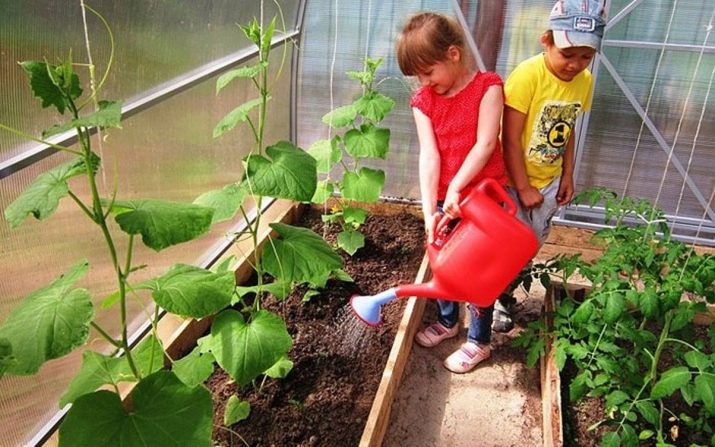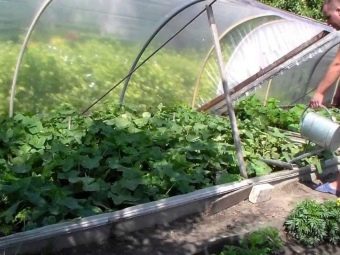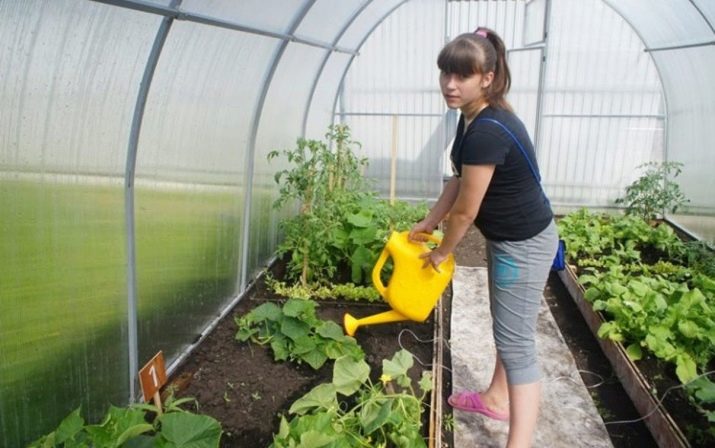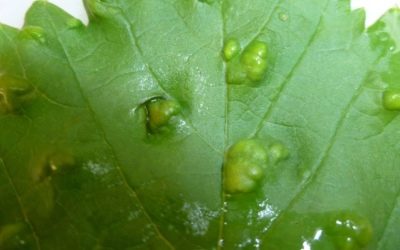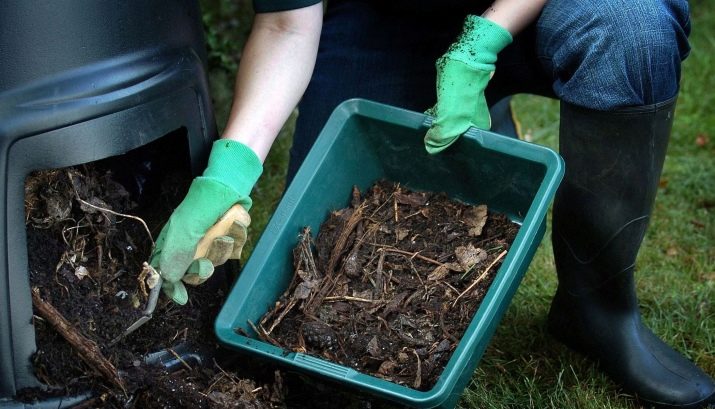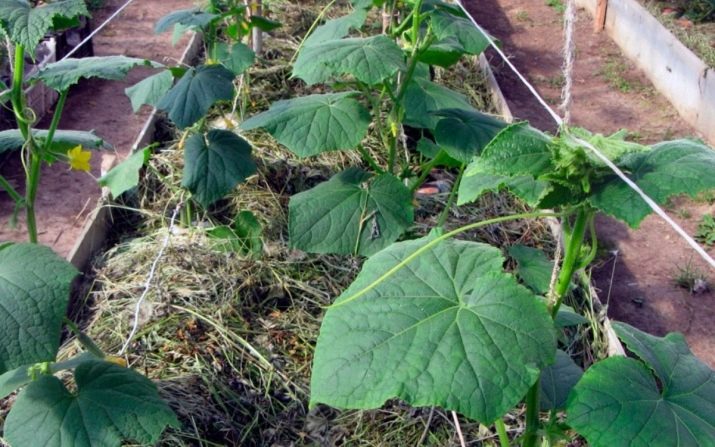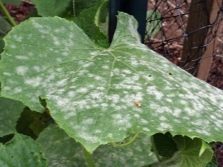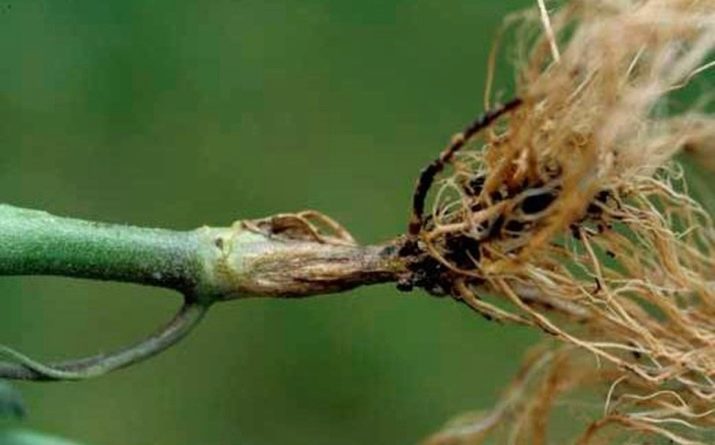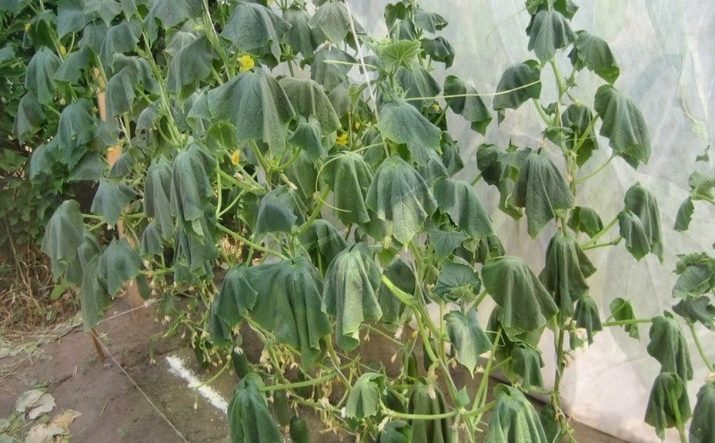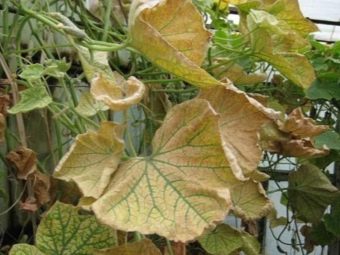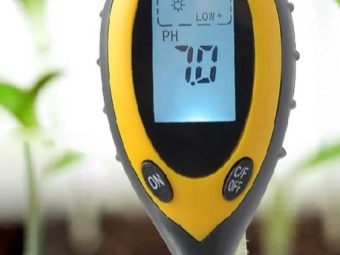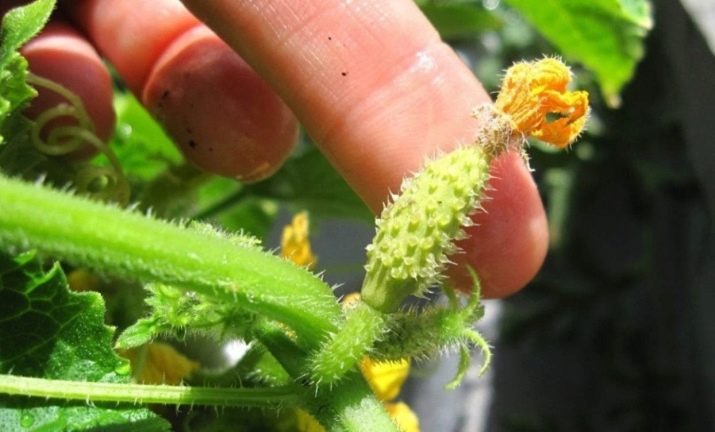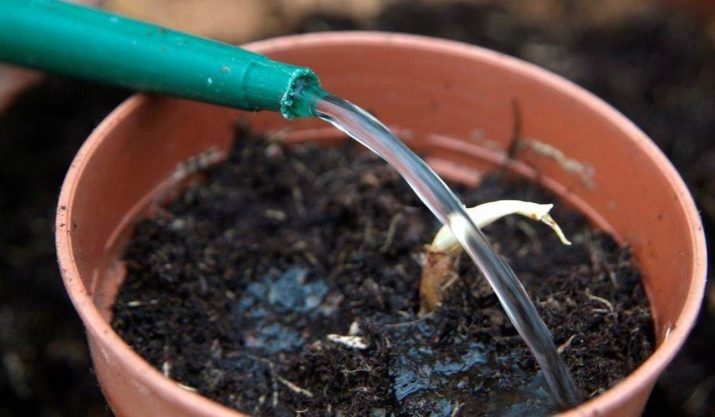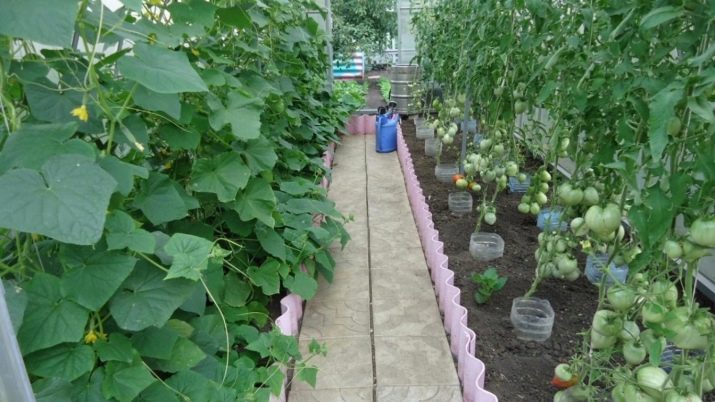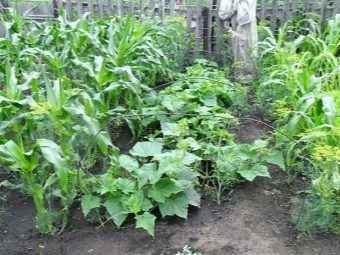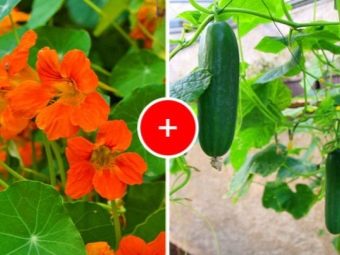How to water cucumbers?
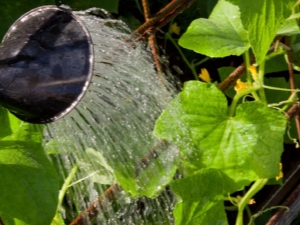
When planting cucumbers on a site fully illuminated by sunlight during the day and having a constantly moist fertile soil, success in growing them is almost guaranteed. In addition, cucumbers, like tomatoes, grown on their own garden beds, have a special taste. The one who tried them once will never follow them to the grocery store.
Most experienced gardeners know that the key to getting a high crop of cucumbers is proper watering. Cucumbers have a very high water content. It is impossible to get a high yield if cucumber plants lack it.
To determine the needs of cucumber water requires more than reading the instructions on the package of seeds. The amount of water is affected by the quality of the soil used, the local climate and the method of irrigation. The irrigation system needs changing during the season.
General rules
In nature, cucumbers get all the necessary water from the rain. However, they are among the most moisture-loving vegetables, and this means that they will need additional watering in cultural conditions.
The cucumber root can reach a depth of 1 m, but its total root system is superficial and is located no deeper than 30 cm from the surface. Because for cucumbers recommended frequent irrigation.
Ideally, watering should be done with warm water 2 times a week. The use of cold water not only creates stress for plants, but also violates soil biology. In compost-based mixtures, nutrition becomes available to plants, largely due to the biological activity of the soil. This process develops only when the soil is warm.
The pH of the water is also important. It should be from 5.5 to 6.0. If the pH is above 7, then it can be lowered by adding nitric, sulfuric or phosphoric acid. If water contains a lot of calcium bicarbonate, then it is necessary to adjust the pH before adding fertilizer to the water, otherwise precipitation may occur.
Periodicity
Assessing the condition of the soil before irrigation is a more reliable way to ensure sufficient moisture than keeping a strict schedule. Watering is needed when the soil has dried to a depth of 2.5-3 cm.
To check the condition of the ground, stick a finger in the ground to about the second joint. If the soil is wet at the tip of the finger, wait with irrigation. This method works both on the open area and for cucumbers grown under film.
Continue to check the condition of the soil daily until you see that it is time to water. Use this method for several weeks by recording the results in a journal. Thus, you will develop a watering schedule, which will need to be adjusted depending on the weather. For example, on a rainy day, plantings may not need irrigation.
In the evening or in the morning?
Watering time is also important. Plants love water, but do not like to be wet. Excessive humidity can lead to fungal diseases, as well as create a favorable environment for the appearance of certain pests. The ultimate goal is to keep the bushes dry at night. If the day is sunny, then water will need a lot and it will be necessary to water early in the morning, while the sun is still low. This will give the plants the opportunity to use the water before the sun is high.
Intense UV radiation can turn water droplets on the leaves into a small lens and burn them. In the afternoon you can water again.
In cold weather
On a rainy day, plants need less water, and you need to adjust this accordingly. Be very careful to avoid overflow. Plants tend to absorb all the water that is available to them. On a sunny day, they can use this water, it evaporates easily. During cloudy weather, plants have a reduced ability to photosynthesis.
Excessive humidity also makes it difficult to displace water, and it can accumulate in the plant cells and cause tears that look like blisters on the leaves. This is called edema, a physiological condition that usually goes away with changing conditions. However, it is better to avoid this problem.
The type and quality of soil in the garden affects the water needs of the cucumber. Ideal garden soil contains approximately equal amounts of loam, chernozem and sand. Excessive clay or sand may damage your plants, preventing proper drainage. Clay slowly absorbs water and slowly gives it away; sandy soil quickly absorbs water and loses it just as quickly. Cucumbers grown in sandy soil usually require additional watering. Clay soil tends to shrink, which prevents the movement of water around the roots of cucumber.
To improve heavy soil, apply organic compost a month before planting cucumbers.
Mulch affects the amount of watering needed for cucumber plants. It retains moisture, so the number of waterings can be reduced. You can use any organic mulch, such as straw, wood chips, or moss.
Overflowing is one of the worst things that can happen in a garden. You may think that watering more often and more abundantly helps your cucumbers to grow better, but the excess water can damage them and even kill them due to the fact that useful oxygen is removed from the soil and the roots are constantly in moist soil. Less frequent, but deep watering causes the cucumber roots to grow deep. Watch your cucumbers and pay attention in time to possible problems that may arise due to improper watering.
Watering the leaves, especially in the evening, can lead to powdery mildew. It appears primarily on the larger and older leaves, causing them to turn yellow and fade. The fruits of cucumber are not directly affected by powdery mildew, but can be burned by the sun, if the protective leaves die and leave them without their protection. Powdery mildew can be successfully fought in the early stages. Make a simple spray by mixing 1 tablespoon of baking soda, 1 teaspoon of vegetable oil and 1 teaspoon of insecticidal soap with 3 liters of water. Spray at least once a week.
Yellowing of leaves is a common sign of soil oversaturation with water. When the roots "sit" in the water, they become unable to absorb nutrients. If the leaves turn yellow from waterlogging, they usually have a stunted appearance and may fall off. In this case, check the drainage around the cucumber roots and reduce watering.
Remember that cucumber roots should never be water.
Yellowing of the leaves can also be an early symptom of root rot. Leaves damaged by root rot can contribute to the development of other bacterial diseases of cucumbers. Fruits grown in heavy clay soils are particularly susceptible to root rot, because there is too much water in this soil. At the roots, constantly residing in moist soil, a fungal disease develops, which ultimately destroys them. Adding humus material such as decomposed leaves or straw, as well as adding sand to the soil improves drainage.
6 signs that you transfuse your plant:
- Your plant fades, although the soil under it is constantly wet. For good growth, the roots of plants need not only water but also oxygen. Overflowing, in simple words, flooded your plant. Between the soil particles there is a space that is filled with oxygen. If the soil is constantly wet, then the number of such air pockets with oxygen is reduced, and the plants cannot breathe. In this case, the plants will wither (which creates the appearance of insufficient watering), although the soil beneath them remains wet.
- The tips of the leaves turn brown.One of the very first signs of overflow can be observed at the tip of the leaves. If it turns brown, it is a sign of excess moisture.
- The leaves turn brown and fade both in case of excessive and in case of insufficient watering. To understand, tear the sheet and squeeze it in your hand. In case of insufficient watering, the leaves will be crispy, and in case of excess water, they will be soft and weak.
- When the roots of plants absorb more water than they can use, water pressure starts to build up in the leaf cells. The cells eventually rupture to form bubbles, and these areas will look like lesions. In the place where the bubbles were originally, brown or white warty sprouts begin to form. In addition, you will see grooves that form directly above the sprouts on the upper sides of the leaves.
- Yellow leaves. Slow growth of plants, coupled with yellowed leaves is a symptom of overflow.
- Leaf fall occurs in situations where there is too much water, and when there is too little water. When both young and old leaves fall prematurely in combination with non-opening buds, this is a sure sign of too much water. Check the soil regularly. Stick a finger into the soil, if at a depth of 2.5-3 cm it is wet and there are some signs indicated above, reduce watering. In addition, many stores sell inexpensive and accurate moisture meters. You just stick them in the ground near the roots and they show how much water is in the soil.
Special cases
Immediately after landing
The soil before sowing cucumbers should be watered five days before the seeds are placed in the soil. This contributes to the active growth of plants. After sowing in temperate climates, the soil under the cucumbers should be daily dipped to a depth of 3 mm. During the first 3 weeks after planting, you can water cucumbers with a sprinkler (on the leaves), but as soon as the cucumbers start to bloom and bear fruit, stop the top watering and switch to irrigation at the root.
Young cucumbers require moderate watering at the rate of 4-5 liters per 1m² of beds as the soil dries. During the entire flowering period, the soil should be moistened every 2-3 days. If the street is very hot, the cucumbers need additional moisture, so you can spend the evening sprinkling. To conduct it, the water rate required during this period of development will have to be reduced by a factor of 2-3. Sprinkling is also carried out before frosts.
If ovaries do not form on cucumbers, watering is undesirable. When fruits begin to slowly form, water cucumbers once a week. Do not overdo it, otherwise the ovary will disappear.
After the growing season reaches a peak, determine the best irrigation schedule according to the condition of the soil at a depth of 2-3 cm. If the soil is still wet there, do not water it.
On the windowsill
Regardless of where you live or how familiar you are with gardening, you can grow at least some of the vegetables on the windowsill. Besides the fact that it will save you money, freshly grown fresh vegetables are much tastier than those bought in the store.
Growing vegetables on the windowsill does not require special skills, a lot of time and money, takes a little time.
There are three ways to grow cucumbers indoors: in containers (soil), hydroponics (water) and aquaponics (aquarium water).
The container method is the most compact, it requires little space and some money. You will need a primer, a pot with holes at the bottom, a pan to collect additional water, heat and light.
Only greenhouse types of cucumbers that do not require pollination and do not require a large area for food are suitable for indoor cultivation.
Soak the soil in water before planting. If you do not do this, then there will remain air pockets in it, in which your seeds or seedlings will float with each watering.Simply pour the soil into the bucket and slowly add water to it, stirring all the time until the soil becomes saturated and spongy.
Watering is one of the most important types of work when growing plants in containers. Lack of water will cause the plants to wither. On the other hand, a glut of water is very harmful.
Cucumbers need plenty of water to be healthy and bear fruit well. They will need from two to three liters of water every day, but do not give the plant all of it at once, do it in 2-3 doses. Always try to water until an excess of water comes out of the bottom of the container, otherwise salt may accumulate in the soil. If this happens, you will see a white precipitate on the walls of the pot. Passing water through the container until excess appears at the bottom will prevent the formation of salts.
If the water does not drain freely, check the drainage holes and evaluate the soil structure. As the organic components of the soil disintegrate, it becomes moist, dense, and contains little air.
Check humidity daily from April to September (twice a day in hot weather)
Covering terracotta pots with waterproof materials is unlikely to significantly reduce the need for water, since most of the water is lost through the leaves of plants. Mulching pots will help reduce soil heating and suppress weeds, but since most of the water is lost through the leaves of the plants, careful watering will still be needed.
The hydroponic system uses water to supply nutrients to plant roots. Instead of soil, the medium is perlite, vermiculite, gravel, or sand. Nutrients are added to water, which cycles through the system.
Hydroponic plants have the same requirements as the soil, but water should be checked daily for pH. It takes a lot of time, so consider this when choosing. You will also need to support the plants on the frame, because there is no soil that would hold them in place.
A hydroponic system can be a costly investment, but you only buy it once and use it for many years. In return, you will receive an abundance of fresh produce. If you want to save, you can build a hydroponic system with your own hands.
Aquaponica is a combination of hydroponics and aquaculture, or fish farming. Instead of adding nutrients to the water, you include an aquarium in the system. Nutrient-rich water from the aquarium is recycled between it and the plants. Plants act as filters, drawing nutrients from the water and sending clean water back to the aquarium.
Recommendations
In a small home garden, space is often limited. You can use mixed landings in this case. Sometimes it is difficult to balance the needs of plants. However, some vegetables grow well together, for example, cucumbers and tomatoes. Associated plants help each other in several ways, including making it difficult for pests to access and provide shelter for beneficial insects.
Tomatoes and cucumbers have the same basic needs. Cucumbers take from 50 to 70 days to reach maturity, and tomatoes from 55 to 105 days, depending on the variety. Both crops are warm season crops that require good drainage and soil pH from 5.8 to 6.5. Also, both cultures require deep watering and a constant supply of water.
In order for these vegetables to grow better together, you need to make the planting with a lower density. Make sure that there is a lot of air in the greenhouse, keep all windows and doors open.
Another important consideration is that it is necessary to water the plantings in the morning, so that in the evening the soil around the tomatoes dries out. However, do not try to keep tomato plants too dry to prevent problems with diseases. If you do, black-brown spots may appear on the tomato fruit.
There are other vegetables that are excellent companions for cucumbers. Peas, corn and beans are plants whose root system increases the nitrogen content of the soil. It becomes available for nearby companion plants. Other useful plants for cucumber are marigolds and nasturtium. Marigold flowers will help scare away beetles, and nasturtiums are unpleasant for thrips and other insects that feed on cucumbers.
Learn more about how to water cucumbers, you will learn from the following video.

